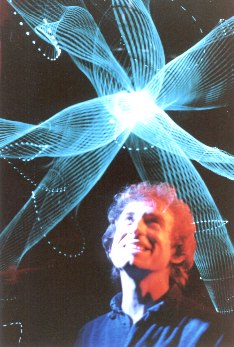

In the summer of 1993 British
Telecom commissioned a large fibre optic sculpture which was exhibited in the
foyer of their head office in London, as part of the Art in the City project.
Located a few hundred metres from St. Paul's Cathedral, at night time BT's vast
atrium window was lit up with this strange 'burning bush'. BT wished to show
a work made with fibre optic as it was the new telecommunication medium.
This was the first project
where I used a computer control system, utilising a PC with a digital to analogue
converter and an industrial digital servo system. Software was developed providing
a graphic user interface which gave clear and precise control of the system
parameters. This made it possible to program long and complex sequences of the
light sculpture's activity without any repetition... organised chaos. In 1994
my work was shown at The Light Fantastic exhibition in Walsall, near Birmingham,
England, a group show of a selection of British artists currently working in
this field. A number of my sculptures were selected for 'Lichtspielereien' a
hands-on exhibition at Technorama, the major science museum in Switzerland .
Some of these works were purchased and are now on permanent display.

 Technorama
next commissioned a large permanent installation for their new Textile section
which opened in December 1995. Named The Light Spinner, this is an imposing interactive
light sculpture which stands about 4 metres high at the front of the Textile Section
of the Museum. Using three 'strings' spinning between two large circular mirrors,
one mounted on the floor and one suspended from the ceiling to create an 'infinite'
tower of reflections. The illustration on the left shows the reflections, the
right shows a close up.
Technorama
next commissioned a large permanent installation for their new Textile section
which opened in December 1995. Named The Light Spinner, this is an imposing interactive
light sculpture which stands about 4 metres high at the front of the Textile Section
of the Museum. Using three 'strings' spinning between two large circular mirrors,
one mounted on the floor and one suspended from the ceiling to create an 'infinite'
tower of reflections. The illustration on the left shows the reflections, the
right shows a close up.
 A touch screen computer is used to control The Light Spinner with interactive
and non-interactive modes. In the interactive mode, at a touch of the screen,
all three 'strings' can be changed to different colours in varying combinations
of activity. Left alone the non- interactive mode will start to control the
sculpture automatically. This enhances the eye catching quality of the work,
insuring that there is always changing activity.
A touch screen computer is used to control The Light Spinner with interactive
and non-interactive modes. In the interactive mode, at a touch of the screen,
all three 'strings' can be changed to different colours in varying combinations
of activity. Left alone the non- interactive mode will start to control the
sculpture automatically. This enhances the eye catching quality of the work,
insuring that there is always changing activity.
1995 also saw the completion
of a smaller piece, Light Wave, using the same control system as the Light Spinner.
It is a free standing sculpture 2.5 metres tall. It was first exhibited unfinished
without a computer in Japan at Artec '95 in where it received a Recommendatory
prize. After completion it was shown here in England.
 In 1996 using the computer programming language Delphi, I created, Zip
Art which lets you draw surprisingly subtle and beautiful images and Visual
Music using special drawing tools I have developed. Go to Java
Zip to get a taste of what this is all about. Java Zip is an interactive
Applet written in Java. You can try out a selection of the special drawing tools
available with Zip Art. On many of the Web site pages you will see small images
made with it. In the Picture Gallery you
will find larger images drawn with Zip Art.
In 1996 using the computer programming language Delphi, I created, Zip
Art which lets you draw surprisingly subtle and beautiful images and Visual
Music using special drawing tools I have developed. Go to Java
Zip to get a taste of what this is all about. Java Zip is an interactive
Applet written in Java. You can try out a selection of the special drawing tools
available with Zip Art. On many of the Web site pages you will see small images
made with it. In the Picture Gallery you
will find larger images drawn with Zip Art.
These pages have
described a selection of activities from early parts of my career. For information
about work since 1996, follow
the links in the
Home
Page
" THE FUTURE OF ART IS LIGHT " Henri
Matisse

First
Page | Previous
Page

You
can download ZIP ART for Windows free.
Download
Now ZIP file format, 800 KB.


Home
Page | Zip Art | Gallery
Guide | What's New










